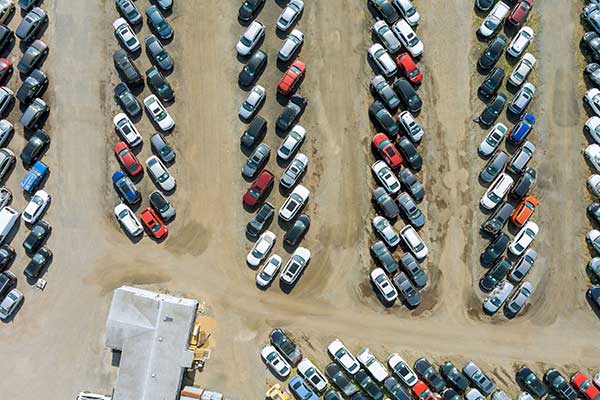James Smith, General Manager and Founder of National Salvage Direct Association (NASADA online.com), provides an enterprise-level solution to the total loss/salvage industry, without the enterprise-level downside. He tells Auto Recycling World his thoughts on the benefits of bringing real change to the way the auto salvage market operates.

Maybe before answering that question, we need to establish exactly what the salvage market is. In its most basic form, the salvage market consists of three primary parts: Sellers, buyers, and a middleman.
- Toy fairs saved thanks to Callander museum family
- 20 Best Sunday Markets in London (2023)
- This Week's Major Events: Antiques Fairs from D.C. to London, An Array of Fashion Exhibitions & Must-See Modern Art Shows
- Antique Fairs in Bristol
- Toy Fair New York Set to Take Place September 30 to October 3, 2023
- Sellers are typically insurance companies and others that provide ELVs and even repaired salvage vehicles.
- Buyers include used auto parts sellers, scrap metal dealers, repair shops, and others that see value in a damaged vehicle.
- The middleman is an individual or a business with a venue and system to make a sale possible.
Do you remember the first time you experienced a salvage auction?
You are watching: Is it time for the auto salvage market to change again?
Mine dates to the late 1970s. There was a small salvage sale on Factory Ave. in the Syracuse area of New York. There was a small registration building where you would receive your bidder number and instructions on how to bid. In this case, the sale was a sealed bid sale, meaning you would write down the amount you were willing to spend on a particular vehicle then seal the envelope with your bid inside it. Either the next day or a few days later, you would receive notification of any vehicles you were the highest bidder on. This was not my favorite way to buy and certainly not a customer-centric experience. My guess is the consigners didn’t get much better treatment than the buyers. It was junk, a junk sale of junk vehicles in a dumpy, dirty sales yard where friends and comradery didn’t exist.
Let’s fast forward a few years to a more modern era. Now we progress to a relatively well-organized storage lot, a live bid, walking from vehicle to vehicle sometimes with the auctioneer in the back of a truck with a loudspeaker. At least there you knew the moment the auctioneer said SOLD you owned it. You were still buying a chunk of metal that visually you had inspected (hopefully before the auction started). It was still easy to miss items, and forked vehicles found a way to incur more damage the longer they sat on the sales lot. It really has stayed this way for years now with only minor improvements.

I wonder what would happen if Amazon adopted the salvage vehicle auction model? For example, would they tell you the ‘Bread Maker’ you wanted will be available for sale at 2:33 pm this coming Wednesday? Provide some pictures and some general information about it and explain that all sales are final, and they aren’t responsible for any additional damage or there may be unexpected damage? Would they include that the item is non-returnable (if it leaves their facility), and if you bought it over the internet, you would be charged an additional fee (for the convenience, of course)? And regardless of where you buy from (either from their facility or via the internet), you would be charged to buy it. Unless you’re the seller, then you’ll have to pay to sell it as well. Don’t forget the shipping, or rather, being moved from the shelf to the loading dock, that would be another fee. And finally, the transportation/shipping would be your responsibility, and you would only be able to pick it up at specific times.
I don’t think that would go down very well, do you? Why are we expected to accept it here in the salvage industry if it doesn’t work there? Is it time to bring real change to the industry, and what would real change look like?
Real change would require addressing the needs of both the buyers and the sellers in the salvage vehicle sales cycle. It would require new and robust systems and processes designed from the ground up with those needs in mind. It would require a shift in the paradigm of what an auction is and how it functions. Would it even be called an auction anymore?
Read more : Hit PBS Series ‘Antiques Roadshow’ to Visit Raleigh on May 16
Maybe the new term would be a secure marketplace. A place you could go to post for sale, browse what was available, search for what you need, and buy when you need it. It wouldn’t be at the convenience of the marketplace for when you post or buy; it would be at your convenience. It wouldn’t cost extra to buy or load or even where you buy from; it would just be the price you paid at the end of the sale. For sellers, it would be no delays and extra storage fees waiting for specific days or having salvage vehicles moved from location to location. It would be not waiting for days or weeks to be paid for vehicles sold. It would be delivering paperwork once, and that would be to the buyer. It would be a known affordable cost – one single fee that covers everything, not a series of fees that add up to needing an accountant to sort through.

This would be a good start and then, as the need arise, make small changes to better serve the buyers and sellers.
Sometimes a little anger and the attitude of “I’m not gonna take it anymore” is the answer.
If you would like to get in touch with James to discuss further, please email him at jrsmith@nasadaonline.org
Source: https://antiquewolrd.com
Categories: Antique News

